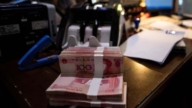【新唐人2013年12月04日讯】中共第五代领导人上任后,由于对地方债务的担忧,已责令地方政府债务治理工作组到各地调查。而统计署上报国务院地方债务最新数据,已经将近50天,中共新政却迟迟没有对外公布,引发国内外专家和机构高度关注。外界质疑,统计署最新公布的地方债务数字之惊人,可能使中共新政不知所措。
10月20号,中共审计署向国务院汇报了地方债务最新规模,对于刚刚出炉的数字,社会各界,包括外国金融机构都颇为期待。但是直到今天,审计署也没有向外界公布结果,引起各界的广泛猜测。
11月中旬,国际评级机构“穆迪”,向中共财政部金融司商讨地方债问题,但是到目前为止,中国的地方债务数据,还是难以获得。
11月30号,中共官媒《新华网》发表文章声称,地方债测算的两个主要部门——财政部和审计署,一直以来因为统计口径的不同,测算结果也存在差异,统计结果还没有确定,难以公布。
美国南卡罗莱纳大学艾肯商学院教授谢田:“我想这个数字没什么值得担忧的话,中共它也不害怕公布,不是很危险的话, 中共甚至不会派工作组下去调查,如果公布出来是20万亿,甚至更多,会产生非常大的恐慌,如果就不公布的话,显然面临着国内外巨大的压力,人们都在问它为什么不公布,公布一个虚假的数字的话, 等于把它自己跟它前任的造假捆绑在了一起。”
今年初,在社科院举办的地方政府信用评级研讨会上,社科院金融研究所研究员刘煜辉估计,目前中国的地方债务 “黑洞”已经突破20万亿元。
大陆《财新网》10月16号报导,“渣打银行”发布研究报告,预计中国地方政府性债务总额可能超过24万亿元。
而12月3号,中国《财经网》,引述“国家信息中心经济预测部”首席经济师祝宝良的话说,他所在的机构通过测算显示,中国地方政府债务规模约为20万亿。
大陆金融分析师任中道:“20万亿也好,24万亿也好,都占到了GDP的一半,就是说产生出100块钱的价值, 50块钱这个债务是不算数的。那就是说,中国的民众他的努力产生出来的价值是去还债了,让中共给用了。”
大陆企业观察员何军樵:“这个政党和这个政府所有的数据都是保密的,很难确定它的地方债务到底是多少,我们只能从某些资金市场去推测,前一段时间银行的钱荒也表明了这样一个问题,各级地方政府对自己的债务是多少,估计他们能搞得清,至于中央能不能搞得清,我都表示怀疑,经济学家或有关金融专家他们能不能搞得清,我也表示怀疑。”
审计署上一次公布全国地方债务数据,是2011年6月,审计结果显示,截至2010年底,全中国地方政府性债务余额超过10万7千亿人民币。
就在当时,审计署公布数据不过十天,“穆迪”便发表报告指出,中国地方政府债务负担,可能比审计估算数字多出3万5千亿。
对此,刚参与完查账工作的某地方财政局人士对《新华网》表示,此次审计署查账工作主要是基于2011年的增量情况做出统计。这位人士还表示,从中央到地方没有一套完整的风险预警机制,而平时设立的一套用来应付审计检查的方法,一定程度上误导了审计,导致债务规模难以统计。
任中道:“地方政府很多借债都是从银行贷款出来的,如果地方债发生了债务违约,银行就产生了坏账呆账,几十万亿的呆账,会让整个银行系统可能就是崩溃的状态,中国民众的钱存银行现在都不安全。”
美国《纽约时报》指出,一旦中国经济出现下行,地方政府的高负债必然会成为中国经济的隐患,最后引发债务危机。
采访编辑/刘惠 后制/陈建铭
The CCP Faces The Latest Local Debt Dilemma
Upon taking the office, the fifth generation of CCP leaders
has ordered local task forces to compile information on
local debts.
It’s been nearly 50 days since the new data collected by the
National Audit Office was presented to the State Council,
yet the information remains unavailable to the public.
Experts and institutes both domestic and foreign have shown
their concern and suspect that the overwhelming data
has caused a dilemma for the new leadership.
On Oct. 20, the CCP national audit office reported the latest
local debts to the State Council.
Various sectors and foreign financial institutions have
anticipated the results, yet they still haven’t been made public,
and people are wondering why.
Even though the international credit rating agency Moody’s
made an inquiry on the local debts data in mid November,
the has data remained a mystery.
On Nov. 30, CCP official media Xinhua reported that
data publication has been delayed because of variations
in data analysis due to different statistic standards employed
by the Ministry of Finance and the National Audit Office,
and thus the result is yet to be concluded.
Xie Tian, business professor at University of South
Carolina Aiken: “I believe if there the data was nothing to
worry about, the CCP would have published it already.
If it weren’t a crisis, the CCP wouldn’t have assigned
a task force for the investigation.
If the debts are 20 trillion or more,
it will create a greater panic.
If they don’t publish it, they will obviously face greater
pressure from both at home and abroad asking
why the data is not released.
If they release a false figure, they will tie themselves with
the fraud of their predecessors."
Earlier this year the Chinese Academy of Social Sciences
organized a local government credit ratings forum.
Liu Yuhui, Institute of Finance and Banking researcher at
CASS reported that local debts exceed 20 trillion yuan
($3.3 trillion).
In an Oct. 16 Caixin.com report, Standard Chartered Bank
estimated China’s local debts have exceeded 24 trillion yuan
($3.9 trillion).
On Dec. 3, Caijing.com quoted Zhu Baoliang, chief economist
of economic forecasting department, State Information Center,
saying that China’s local government debt is about 20 trillion.
Ren Zhongdao, financial analyst: “20 trillion or 24 trillion
yuan, either way it’s half of the GDP.
That means for every $100 made, $50 is for the debts.
That is to say, half of what the people have produced is used
by the CCP to pay the debts."
He Junqiao, mainland China enterprises observer:
“The Party and it’s regime’s data is all confidential.
It is difficult to determine the exact amount of local debt.
We can only speculate from the market.
The bank’s money shortage that happened not long ago
also had the same issue.
Local governments know exactly how much they owe.
As for the central, I doubt if they have a clear picture of it.
I am also skeptical of whether economists
or financial experts can really know the details."
According to the national audit in June 2011,
by the end of 2010, the total local government debt balance
was over 10.7 trillion yuan ($1.76 trillion).
10 days after the official report, a report published by
Moody’s indicated that Chinese local government debt may be
3.5 trillion yuan ($540 billion) higher than the Chinese data.
A local finance bureau official who participated in the audit
told to Xinhua that the Chinese data
was based on 2011 increments.
The official also said that due to the lack of a comprehensive
risk warning mechanism from the central to local,
the conventional audit tends to mislead the analysis to
some extent, and thus the total debts become a difficult task.
Ren Zhongdao: “Many local governments borrow through
bank loans.
Any default on a loan will result in bad debt for the bank.
A bad debt of tens of trillions of yuan could result in
the collapse of the entire banking system.
Keeping money in the bank is not safe for the Chinese now."
The New York Times Chinese reports that
once the Chinese economy is down,
high local debts will inevitably pose risk to China’s economy,
and finally lead to a debt crisis.
Interview & Edit/LiuHui Post-Production/ChenJianming


























